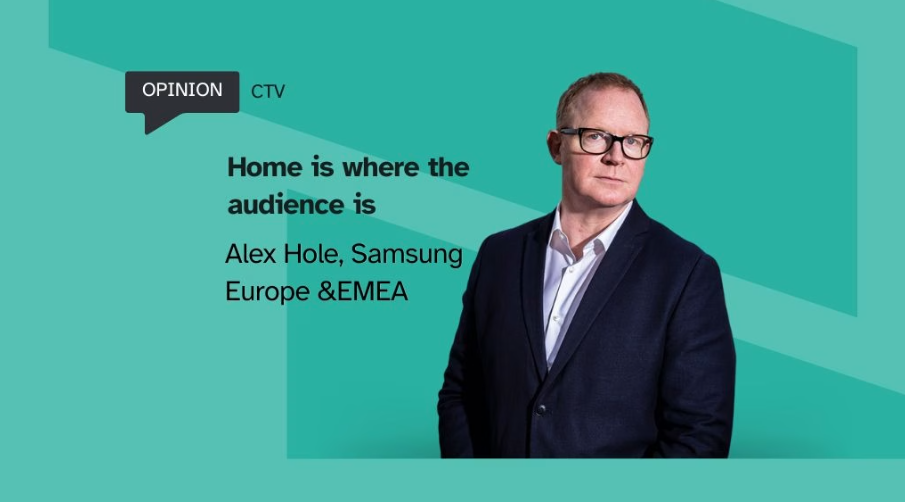Home is where the audience is

By Alex Hole, SVP and General Manager, Samsung Europe and MENA
What do you remember about 2010 – the year Icelandic volcano Eyjafjallajökull grounded European flights and skeleton racer Amy Willliams won the UK its first individual British gold medal at the Winter Olympics in 30 years? Maybe you’ll recall that One Direction were formed on The X Factor that year, while Kara Tointon won Strictly Come Dancing and Downton Abbey made its first appearance on UK screens.
Whatever sticks in your head, the chances are that you saw it on television, and a lot of other people watched the same thing at the same time. In 2010, the average time spent watching TV per day in UK homes hit a new record high of four hours and two minutes. Linear TV was at its peak, and through shared cultural moments, advertisers could reach large numbers of us with ease.
15 years later, reaching that mass audience has never been so complex. In fact, in a fragmented market, with linear TV declining and audiences spread across a multitude of apps and channels, the home screen is virtually the only thing every smart TV viewer sees.
That makes it an important media property in its own right, but it’s also a piece of something bigger. Shared, simultaneous viewing of a single TV show has largely vanished into history. And meanwhile, where TV audiences spend their time has become a difficult – but not impossible – question to answer.
But what we know for sure is that future understanding of media consumption must come from cross-device insight and data, with the home screen right at the centre.
A mass audience broken into 2,112 pieces
Before we talk about the home screen, let’s look at the context of the fragmentation TV is now experiencing.
In the UK, our appetite for viewing hasn’t diminished since 2010, but we are certainly watching very differently. In the second half of last year, Samsung smart TV owners spent four hours and 23 minutes watching every day, and on-demand content accounted for 54% of it.
That’s where the big audience has gone, you might say – the BVOD and streaming companies have it. But that underestimates just how extreme the CTV fragmentation has quickly become.
Consider that, according to the findings of our Anatomy of a Streamer report, the average household uses four apps: typically, two subscription video on demand (SVOD) services, an advertising-based video on demand service (AVOD), and a broadcaster video on demand (BVOD) service.
Of course, not every household is using the same four apps. The current app Top 10 allows for 120 different combinations of four. Within the Top 20, that figure rises to 2,112. For brands attempting to find their audience, it all signals a marked shift away from the age of traditional mass-reach TV.
The home screen’s solution to fragmentation
Into this chaotic picture steps a new hero: the OS home screen.
Just as advertisers are looking for mass audiences, viewers are looking for clarity of their own. With so much on offer, finding content has become a time-consuming process. One in four viewers don’t think it’s easy to find content they want to watch, and on average they spend ten-and-a-half minutes finding something to watch.
A programmable navigation tool, a recommendation engine and a key piece of media real estate, the home screen has a rare power to capture the disparate viewing public in one place.
Smart TV users are using the home screen five or more times a day – more than any VOD app. This year, EssenceMediacom predicts that viewers will spend more time navigating TV operating systems than watching any single broadcaster, particularly among younger audiences.
The home screen, sitting at the centre of a spider’s web of app usage, is a hub of this developing world, and it becomes a launchpad for all TV experiences, as well as an important place from which to influence their choices.
We know that smart TV audiences appreciate relevant advertising, and respond to relevant recommendations and messages. 37% want to see ads curated to their interests or the content they are watching. 45% say the primary way they find new products or brands is via ads on the TV. The evolving home screen is a way to do it.
More screens, more data
Now let’s zoom out further. The world doesn’t revolve around a single screen anymore – even if it is the biggest screen in the home. But by combining TV viewing data with insights from mobile, we are able to build an updated understanding of how media is consumed throughout a typical day, across apps and devices. That lets advertisers optimise for omnichannel, and helps them meet the consumer in the right moment.
We know, for instance, that throughout the day, mobile usage and TV consumption steadily rise, and second-screening hits its height during peak and slightly later TV times. That means attention could be lower on the big screen during this time, so it is worth considering engagement ads – such as clickable or QR ads – while the mobile is more likely to be in the viewer’s hand.
Given that usage of different devices fluctuates at different times – mobile usage is lower midweek, TV consumption of all kinds peaks during weekends, and Sunday reliably heralds a boom in mobile app usage – we can say that brands should consider sequential advertising between the TV and mobile to reach and convert through the week.
Media consumption is changing rapidly, and it is never going back to what it was. One buy can’t get you all those eyeballs anymore, but that doesn’t mean we can’t understand where those viewers have gone. Understanding not just the significance of the home screen, but all screens, will once again illuminate the darkened path for advertisers.
Also published in: New Digital Age



